Samyang 24mm f/1.4 ED AS UMC Lens Review
News about lenses and photographic equipment
Samyang 24 mm f/1.4 review on LensTip
The well-known camera equipment tester website LensTip.com published on its pages a test of the Samyang 24 mm f/1.4 ED AS UMC lens, which recently went on sale.
- very good image quality with an aperture of 1.5 stops,
- chromatic aberrations are well controlled,
- decent behavior in backlit bright light,
- good coma correction on APS-C/DX.
- the actual open aperture of the lens is much closer to f/1.8 than f/1.4,
- distortion level is higher than that of competitors,
- weak manual focus ring,
- very high vignetting at full frame,
- the Canon version does not have any contacts,
- poor image quality at open apertures f/1.4 and f/2.0.
After several very successful launches of Samyang products, it may be too hasty to assume that they belong to the elite and can offer a professional lens in every category with parameters and price not much different from other professional products. In the case of the Samyang 24mm f/1.4 ED AS UMC, neither the optics nor the mechanics are worth the amount Samyang put on the price tag. Some minor flaws, which can be completely forgiven in a device costing less than 300 euros, become unforgivable in a lens 2-3 times more expensive.
In such a situation, many who want to buy a lens with similar parameters may begin to look for more favorable offers from competitors. Those who value high build quality may be tempted by the Zeiss Distagon 2/25. And those who don’t like compromises will buy Canon or Nikkor 1.4/24. Others might opt for the Sigma 24mm f/1.8 EX DG Aspherical Macro, which may not be better optically, but when it comes to build quality it certainly beats the Samyang tested here, and it has an autofocus system to boot. One could consider the somewhat narrow angle of view as not a serious drawback and buy the Canon EF 28mm f/1.8 USM, giving much the same reasons for purchase as in the case of the Sigma. As you can see, you have a wide choice. Samyang has always been able to convince people with its best price/quality ratio, but unfortunately this no longer works.
 11136
11136 4
4
 |
wit8370:: 10.06.2017 18:09:47 |
Lv. 1 (Lens-Learner)
Numbers and tests, as everyone knows, are good. But in practice it happens differently. Now, if a person almost never uses an open aperture in his scenes, then his poor test results with an open aperture do not interfere with his life. If there are few contrast transitions in his field of vision, then he doesn’t care about CA tests. And, on the other hand, I shoot open, and the result turns out to be good, despite the tests. I close down to f/8 and again I am more than happy with the result. I bought it a year ago new from a large chain for 37.5 rubles, now I see the price is about the same. Do owners of 38 thousand rubles have much choice? who want a new lens with a 24mm focal length? For example, the classic Canon EF 24-105mm f/4L IS USM and Canon EF 17-40mm f/4L USM are a little more expensive and the quality (sharpness) of the image is debatable. There are second and third generation Elki 16-35, high-aperture branded primes, etc., but they cost more than a hundred. The choice turns out to be: Canon EF 24mm f/2.8 IS USM and Sigma AF 20mm f/1.8 EX DG ASPHERICAL RF Canon EA and, in fact, “our hero” in one of its two guises: Samyang 24mm T1.5 ED AS, oriented towards dslr videography UMC VDSLR Canon EF and with a discrete aperture Samyang 24mm f/1.4 ED AS UMC Canon EF (by the way, it is slightly cheaper than its brother).
Samyang 24mm f/1.4 ED AS UMC AE Nikon F lens review


The 24mm focal length is generally considered to be best suited for landscape or cityscape photography, but in fact this lens has its own flair for many other genres. Due to its wide angle, it allows you to get very close to the subject and thereby convey the volume as much as possible and provide the viewer with an effect of presence that cannot be conveyed with long-focus optics.
Therefore, when planning our review, we decided to try the Samyang 24mm f/1.4 ED AS UMC AE Nikon F not only in the landscape, but also to show its work in other genres of photography.
For the test, we chose a camera with the highest resolution among DSLRs: Nikon D800 with its 36 megapixels should reveal all the possible advantages and disadvantages of our fixed lens.
Constructive

The lens is quite large in size, even slightly larger than native primes for Nikon and Canon.
The design and build of the lens is typical for this company - it is beautiful. There are no backlashes.
The focus ring travel is very smooth (perhaps even too long) and long, this is a clear nod to videographers. Because thanks to this, you can smoothly move the focus throughout the entire range without any jerks.
As we have learned, Samyang Optics Co. Ltd., in addition to its own Samyang brand, also produces lenses under the brands Vivitar, Bower, Opteka, Walimex and several others, even less known to Russian photographers. The only difference between these brands is that the plant’s own line of optics is the most complete. In our country, the company is officially represented only under its own brand, that is, full service is available only for Samyang lenses.
Another new feature of the manufacturer is the use of new technology of multi-layer anti-reflective coatings UMC (ultra multi coating) in this lens, which gives excellent color rendition even when shooting against the sun.
Recommended price in Russia: 23,860 rub.
Specifications
| Purpose | Wide-angle/video |
| Focal length | 24 mm |
| Design | 13 lenses, 12 groups |
| Field of view angle | 84° |
| Focusing | manual |
| Minimum focusing distance | 0.25 m |
| Minimum aperture | f/22 |
| Bayonet |
|
| Number of aperture blades | 8 |
| Relative hole | f/1.4 |
| Thread diameter for filters | 77 mm |
| Dimensions | 87.5 mm x 83 mm |
| Hood | removable, mount |
| Weight | 680 g |
Photography practice and optical properties
The first question that arises for any photographer reading about a manual focus lens is how convenient is the focusing mechanism? When focusing this lens, any experienced photographer will undoubtedly receive a portion of positive emotions. You could even say that the trick of this lens is manual focusing. We highly recommend you try it and evaluate this moment for yourself.
Testing has shown that using the viewfinder it is quite difficult to focus on objects very distant from the camera. In such situations, we recommend using the camera's built-in focus confirmation indicator, which is commanded by the forcedly inactive but very sensitive autofocus system.
The first thing I want to try with this prime is to shoot at an aperture of f/1.4.
At an open aperture, the depth of field is quite shallow, especially when shooting from short distances. At the same time, the lens has very interesting bokeh, contrast and a “cinematic” picturesque transition from sharpness to blur.
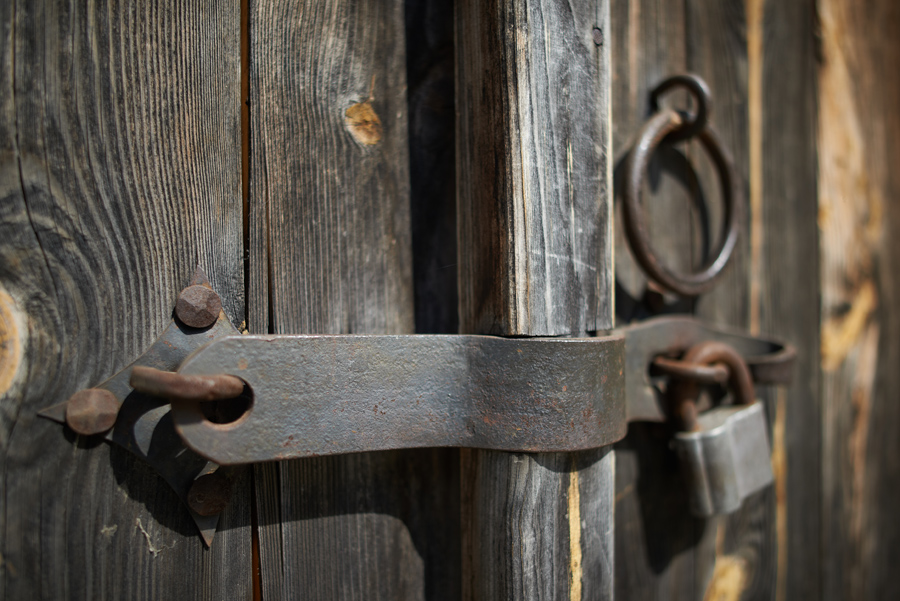
Camera: Nikon D800 / Shutter speed: 1/5000 / Aperture: f/1.4 / ISO: 100
I was also very pleased with the volume created by the lens in the picture at minimum focusing distances.

Camera: Nikon D800 / Shutter speed: 1/160 / Aperture: f/4.0 / ISO: 100
Sharpness
The 36-megapixel matrix gave us the opportunity to seriously evaluate not only the sharpness of the lens, but also its resolution.

Camera: Nikon D800 / Shutter speed: 1/400 / Aperture: f/7.1 / ISO: 100
Let's look at two 100% crops from this shot and evaluate them.


The lens provides very good, almost flawless sharpness in the center of the frame, but at the edges we see a slight weakening. The lens is slightly lacking in edge resolution, but given the resolution of the sensor, this fact can be considered insignificant.
Vignetting
In the f/1.4-2.8 range, vignetting is very noticeable; further on in the f/4-5.6 range it is very weak and disappears completely starting from f/8.

Chromatic aberrations
The lens has a very low level of chromatic aberration. They are so insignificant that it can be said that they are almost completely absent.
Distortion

Camera: Nikon D800 / Shutter speed: 1/6400 / Aperture: f/3.2 / ISO: 100
The Samyang 24 mm, of course, has distortions, but, as we can see from the horizon line in this frame, they are insignificant.
Depth of field
From these frames you can estimate the depth of field of the lens at different aperture values.

Camera: Nikon D800 / Shutter speed: 1/100 / Aperture: f/14.0 / ISO: 100

Camera: Nikon D800 / Shutter speed: 1/400 / Aperture: f/9 / ISO: 100

Camera: Nikon D800 / Shutter speed: 1/400 / Aperture: f/7.1 / ISO: 100

Camera: Nikon D800 / Shutter speed: 1/1250 / Aperture: f/4.0 / ISO: 100
The last shot clearly illustrates the beautiful softness of the lens when shooting close-up portraits wide open. Videographers should appreciate this one.
Shooting video
We decided to use the so-called time-lapse photography available in our camera and make such a fun video. Those interested in watching a more classic video can do so below.
Results
Pros:
- Excellent design
- Smooth focus ring movement
- Beautiful bokeh
- Confirming focus and recording lens data for Nikon F and Pentax K cameras
Minuses:
- Lack of autofocus
- Vignetting on open apertures
- Slight lack of resolution at the edges of the frame
Our opinion:
The lens clearly has a good price/quality ratio and has a great chance of becoming the first wide-angle prime in the lineup for many photography enthusiasts. Also, in our opinion, videographers will appreciate it for its smooth and long focusing and beautiful pattern at open apertures.
Samyang 24mm F1.4 ED AS IF UMC Lens Review


Samyang 24mm F1.4 ED AS IF UMC is a non-autofocus fast wide-angle lens with a good price/quality ratio.
This model from the Korean manufacturer is available for all popular mounts: Canon EOS, Nikon F, Pentax K, Sony A, Canon M, Fujifilm X, Samsung NX, Sony E, Micro 4/3.
Design Samyang 24mm F1.4 ED AS IF UMC

| groups/elements in the lens | 12/13 |
| viewing angle (35 mm) | 84,1° |
| minimum focusing distance (m) | 0,25 |
| maximum aperture value (f) | 1.4 |
| minimum aperture value (f) | 22 |
| aperture blades | 6 |
| filter diameter (mm) | 77 |
| Weight (gram) | 590 |
All modifications of the lens for various mounts have a single optical design, but differ in size and weight. So lenses for DSLR cameras are lighter and more compact, while for mirrorless cameras, on the contrary, they are larger and heavier. This is due to the fact that
The optical design consists of 13 elements in 12 groups. These include two aspherical lenses and four ED glass elements. Multi-coated lenses (UMC) minimize flare and flare.
The lens body is made of high-quality and pleasant plastic and has an aluminum alloy frame. The build quality of the Samyang 24mm F1.4 is excellent.
The focus ring is rubberized, the aperture ring is plastic.
Image quality
Sharpness and detail
The lens shows good detail.
Sharpness at an open aperture of f/1.4 is acceptable, although for best results it is better to use f/2 and f/2.8, which provide an excellent balance of sharpness and shallow depth of field.
 1/6000, F/1.4, ISO 100
1/6000, F/1.4, ISO 100
At f/4 aperture the sharpness becomes better, at f/5.6 and f/8 the lens gives maximum sharpness.
Further, the sharpness decreases, closing the aperture to f/11, the sharpness is good, at f/16 it noticeably weakens, and f/22 is already very soapy.
Vignetting
At an open aperture of f/1.4, strong vignetting is noticeable. It gradually weakens as the aperture is closed and disappears at f/5.6.
Distortion
Distortion on a mixed type lens. It can be edited quite successfully in a RAW converter. At the same time, Lightroom has built-in individual profiles for each mount.

Chromatic aberrations
Chromatic aberrations are very minor.
The bokeh pattern is interesting, contrasting and quite picturesque. At the same time, the lens has a soft transition from sharpness to blur.
Practice of use
The 24mm focal length is perfect for landscape, street and genre photography. With such a focal length, you can shoot interesting scenes while being directly in the center of events. In this case, perspective distortions will be insignificant.
 1/1000, F/4, ISO 100
1/1000, F/4, ISO 100
In the test sample, the focus ring moves too easily, this makes focusing difficult; you have to adjust the ring literally a fraction of a millimeter, and any awkward movement shifts the focus, especially if shooting at an open aperture.
The Samyang 24mm aperture ring switches in 1/2-stop increments (with one-stop steps between f/1.4 and f/2 apertures) and is clearly fixed at the selected aperture.
Working with a wide-angle non-autofocus lens has its own characteristics.
When shooting a landscape, focusing is difficult because all the objects in the frame are very small.
In this case, the “focus assist” mode helps, with the ability to zoom in on the area of interest for fine-tuning. The hyperfocal distance for an f/5.6 lens starts at 3.4 meters.
When shooting with backlight, the lens produces contrasting shots.
 1/800, F/5.6, ISO 100
1/800, F/5.6, ISO 100
One more thing. The lens for mirrorless cameras is noticeably longer than for DSLR cameras. This is due to the fact that the optical design of all lenses is the same, but the bodies are different in accordance with the working distance of the camera.
As a result, the compact full-frame Sony A9 with which we tested the lens received a huge lens that outweighs the camera and creates unnecessary pressure on the hand. This is the situation with all mirrorless cameras.
conclusions
Samyang 24mm F1.4 ED AS IF UMC combines high image quality, pleasant bokeh and good sharpness at an affordable price.
It is perfect for landscapes, starry sky photography, travel photography and street photography.
 1/1000, F/4, ISO 100
1/1000, F/4, ISO 100
Is it worth buying
If you need a wide-angle, fast lens and don’t strictly need autofocus, go for it!
Samyang 24/1.4 ED AS IF UMC
Review and test of the Samyang 24/1.4 ED AS IF UMC lens
Almost all full-frame Samyang lenses existing at the time of the review were tested (including the “relatively full-frame” circular fisheye Samyang 8/3.5); the Samyang 24/1.4 ED AS UMC, the most expensive lens in the company’s line, remained unknown.
Samyang 24/1.4 ED AS IF UMC was announced in August 2011, the model went on sale in early 2012; This is the newest lens in the company's lineup at the time of review.
Over the six months of its presence on the market, Samyang 24/1.4 ED AS IF UMC has received a lot of criticism. In addition to complaints about the high price compared to its predecessors, the main ones were:
Technical characteristics of Samyang 24/1.4 ED AS UMC
Optical design: 13 elements in 12 groups, including 4 low dispersion ED elements and 2 aspherical
Field of view (diagonal): 84 degrees
Aperture range: f/1.4 – f/22
Number of aperture blades: 8
Minimum focusing distance: 25 cm
Filter diameter: 77 mm
Dimensions: 9 7.5*83 mm
Versions available for: Canon, Nikon, 4/3, Pentax, Sony Alpha and Samsung NX
Contents of delivery
Traditional for Samyang lenses. The test copy came in a colorful box of a new design. In the box:
Quality of materials and workmanship, ergonomics
Samyang 24/1.4 UMC is the company’s attempt to enter a higher price category. Under the Samyang and Rokinon trademarks it is offered for $700, under the Bower name it is $10 cheaper. The price makes us have slightly different requirements than other Samyang lenses: we are talking about a non-autofocus lens from a third-party manufacturer.
The materials are no different from those used in other Samyang lenses. In general, no complaints or comments: good plastic, no play or looseness, high-quality assembly. However, taking into account the price of the lens, we get a psychological study: how different is the perception of the same plastic and similar assembly on two lenses - for 300 and for 700 dollars? I admit, everything looks much better on a $300 lens.
Only the lazy did not talk about the 3 screws that hold the bayonet mount: not enough for a lens weighing 700 grams. By the way, as far as I know, there are 4 of them in versions for Nikon and Olympus.
The focusing ring is wide – 4.5 cm (3 of them are covered with corrugated rubber), conveniently located, and well damped. On the tested sample, the often mentioned problem with focusing (when the direction of rotation is reversed, the ring appears to have free play) is absent - the company has probably made changes and removed the annoying defect.
When focusing, the rear group of lens elements moves, which leads to a slight change in the angle of the field of view: the lens becomes “narrower” when focusing on close objects.
The ring for changing the aperture value is wide enough for comfortable work - 8 mm, it clicks clearly. 1-stop increments are present from f/1.4 to f/2.0 and from f/16 to f/22. In the rest of the range, the step is 0.5 steps.
There is no distance window; the scale is located on the lens body and focus ring.
The front element is noticeably convex, but the cut of the lens with a thread for a filter protrudes forward, which allows you to use filters without any problems. The front element does not rotate when focusing, and the lens does not change its external dimensions.
Geometric distortion
Samyang 24/1.4 ED AS UMC showed barrel distortion of 2.55% - in principle, not criminal for a lens with a focal length of 24 mm, but slightly more than expected.
Sharpness and Resolution
Samyang 24/1.4 ED AS UMC was an unpleasant surprise: usually, when prices rise, it is logical to expect an increase in quality, or at least maintaining the usual level (I’m talking about lenses, not about housing and communal services). The Samyang 24/1.4 UMC performed weaker than other lenses from the company: at open apertures there is uniform, powerful blur across the entire field of the frame, the center becomes quite good at f /2.8, and we can talk about good sharpness only starting from f /4. To the credit of the lens at f /5.6 and f /8.0 - without any complaints.
The strength of Samyang lenses was precisely their resolution, which made it possible to compare them with much more expensive analogues. Samyang 14/2.8, 35/1.4 and 85/1.4 perform well in comparison with their analogues, and the price makes you forget about the inconveniences of non-autofocus. The hero of the review is more reminiscent of the autofocus Canon EF 24/2.8, which costs half as much.
f/1.4
f/2.0
f/2.8
f/4.0
f/5.6
f/8.0
f/11
f/16
About the method of displaying data - in the material “Reference Point”.
Vignetting
Samyang 24/1.4 ED AS UMC also does not shine in this discipline. With the aperture wide open, darkening in the corners of the frame exceeds 3.5 stops, with virtually no reduction at f/2.
At closed apertures the situation improves, but relatively – even at f/8.0 vignetting exceeds the comfortable level by 1 stop:
Focusing
I’ll be honest: I couldn’t beat the Samyang 24/1.4 ED AS UMC: I couldn’t focus through the viewfinder. Or rather, almost not so: at a distance to the object exceeding 50 - 70 cm, at apertures f / 1.4 - f / 4.0, rare hits in focus were rather accidental, at f / 5.6 and beyond - due to the considerable depth of field of the wide-angle lens.
An acceptable level of focus hits was achieved only by using LiveView. And here, not everything is so simple: the focus ring travel is almost 160 degrees, which - it would seem - ensures the comfort and accuracy of the process. But look at the markings of the distance scale: of these 160 degrees, almost 140 are in the range from 25 cm to 1 meter, which would be appropriate on a macro lens, but incomprehensible on a wide-angle lens. For the entire range from a meter to infinity (including “flying” beyond infinity), a measly 20 degrees of rotation of the focus ring remains. At distances between 1 and 2.5 meters, pointing becomes a test even when using LiveView.
I also agree with the complaints about the easy movement of the focusing ring: the ring is wide, located exactly where the hand supports the lens, it’s easy to change the setting.
Chromatic aberrations
Samyang 24/1.4 ED AS UMC controls chromatic aberration relatively well at open aperture values, which are of little use due to soapiness. At full aperture, the width at the corners of the frame is 2.35 pixels. At closed apertures there is nothing to brag about: CA does not fall below a comfortable level of 1 pixel:
Everything is fine with the coloring of out-of-focus areas - no complaints. The lens also performed well in difficult lighting conditions: the appearance of artifacts can only be achieved with effort and at open aperture values.
Conclusion
I didn't like Samyang 24/1.4 ED AS UMC. The hero of the review seemed to be the weakest and most compromise in the Samyang lens line.
The price only reinforces the negative impressions: if it were usual for the company’s lenses ($300-400), the lens could be considered as some kind of alternative to the Canon EF 24/2.8 for amateur photographers who fall under the magic of f/1.4 in the lens name. For over 700 dollars, I don’t recommend it.
I thank Vladimir (www.foto-canon.com) for providing a copy of the lens for testing.
September 2012
Edward ( Sunday, 27 November 2016 11:06 )
Hello!
Thank you very much for the reviews on your site!
I choose a lens:
Sigma AF 20/1.8 EX DG Aspherical or
Canon EF 20/2.8 USM or
Samyang 24/1.4 ED AS IF UMC.
(used prices in a row: 20,000 rubles, 18,000 rubles, 24,000 rubles) Please advise where to choose? Or maybe there is an alternative?
Vlador ( Sunday, 27 November 2016 11:28 )
Good afternoon
You can come up with alternatives, but they won’t be quite alternatives because of the price - the same Sigma Art 20/1.4, if you need a 20 mm prime. The choice will be yours, I can only make a few comments on my part:
- I didn’t like Samyang on the test, and I don’t like it now;
— if we are talking about a full frame, then all three proposed options are compromises (20-24 mm focal length is most often in demand for landscapes/general plans, where uniform sharpness across the frame is often more important than high performance in the center)
If we are talking about a full-frame camera, I would stop at the Samyang 14 mm (after all, you can crop up to an angle of 20-24 mm), and if you plan to use the lens on an APS-C camera, then on Canon/Sigma - whichever one will be cheaper and in better condition (the difference in picture quality will be small.
Edward ( Sunday, 27 November 2016 18:09 )
Thank you very much for the answer!
It helped to exclude Samyang, because...
I take it for APS-C (forgot to indicate). It helped to take Sigma more relaxed, because...
I practically couldn’t tell the difference, but my soul lay closer to Sigma. Since they are equal, it’s even simpler. Already bought it (used), so far it’s just what I was looking for!
Vlador ( Sunday, 27 November 2016 18:22 )
It’s good that the opinions coincided :) Happy shooting!
[email protected] ( Friday, 06 July 2018 21:21 )
Hello Vlador. I really like your tests. I have never seen such a visual table about sharpness anywhere. If this is not a military secret, do you get these very accurate tables somewhere? About the samyang 24mm f1.4 ED AS IF UMC test. What is here- (IF). This is not by chance a transfer of information about the aperture from the lens to the camera. And this is not by chance an aid in focusing using the - (green dot) indicator. I have a Canon 80D. I looked at the Samyang website today. I carefully (very) looked at this lens. It is a modification for Canon. There, in the photo, there are electrical contacts. The specification says that the lens works with the modes on the camera: (A) (S) (M) - canon. That is, (at a minimum) there should be autofocus confirmation. On the photo of the transport box of the lens you are testing it says - (IF). So, for example, the Samyang 14MM F2.8 ED AS IF UMC-model (modification for Canon), it’s written in the specification that the lens contains a motor and a chip (CPU) and the aperture is controlled from the camera. And focus confirmation works on the camera. The price of this model is approximately 370 USD. Please clarify.What is (IF). And were there any electrical contacts on the samyang 24MM F1.4 ED AS IF UMC lens - this is the one you tested and described.
Vlador ( Saturday, 07 July 2018 12:21 )
Good day!
I use tables from Imatest (as well as an automated testing program).
According to IF: this is Internal Focusing - internal focusing means that the lens does not change its external dimensions when focusing.
I didn’t get my hands on autofocus Samyangs, but I remember that they only had 14 mm and 85 mm in autofocus version for Canon (I’m afraid I’m wrong, but it seems they are only for APS-C, although I’m not sure).
So the abbreviation IF has nothing to do with data transmission and automation.
Regarding contacts - again, I haven’t encountered the Samyangs/Rokinons/Bovers for a long time. At one time, data transfer was ensured by an independent “Dandelion” sticker (Lushnikov chips), but we don’t know how it is now.
Samyang 24mm f/1.4 AE ED AS UMC for Nikon
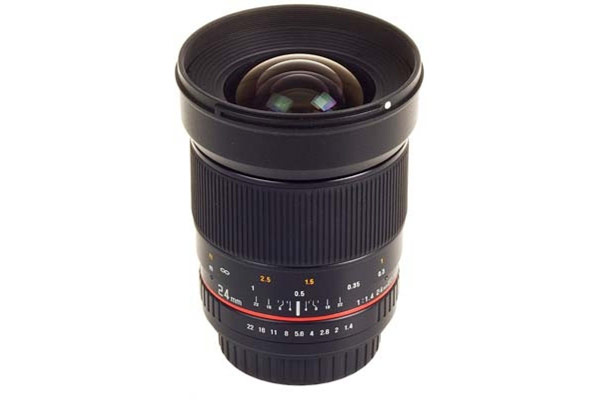
Shipping within the Russian Federation:
to any region from 1 to 14 days
Samyang 24mm f/1.4 AE ED AS UMC lens for Nikon
The Samyang 24mm f/1.4 ED AS UMC AE is an excellent lens with a field of view of 84 degrees in 35mm equivalent and 57.6 degrees when using APS-C digital cameras. It features four low dispersion ED lenses and two aspherical elements that deliver clear, sharp images with minimal chromatic and geometric aberrations. This lens has a minimum focusing distance of just 25 centimeters, allowing you to take stunning wide-angle macro shots. This device is ideal for Nikon digital cameras that use the Nikon F mount. It will perform great when shooting landscapes, interiors, street photography, and when shooting in low light conditions. Thanks to the UMC anti-reflective coating, the Samyang lens copes well with unwanted flare and ghosting.
Samyang 24mm f/1.4 ED AS UMC AE lens allows you to take high-quality images even at wide open aperture, which means first-class sharpness and contrast. Distortion at the edges of images is kept to a negligible range, which is a decent figure, especially for wide-angle lenses.
The differences between the Samyang 24mm f/1.4 ED AS UMC AE and the previous version of the lens mainly relate to the presence of a chip for automatic aperture operation and exposure metering; also in the new version, the design of the body has changed slightly and the coating of the optics has improved. The abbreviations in the lens name are deciphered as follows:
AS - Aspherical, aspherical elements in the optical design
IF - Internal Focusing, internal focusing.
UMC - Ultra Multi Coating, ultra-multi-enlightenment
AE - Auto Exposure, automatic exposure.
Features of Samyang 24mm f/1.4 ED AS UMC AE
The design and build of the lens is typical for this company - it is beautiful. There are no backlashes.
The focus ring travel is very smooth and long, this is a clear nod to videographers. Because thanks to this, you can smoothly move the focus throughout the entire range without any jerks.
Another new feature of the manufacturer is the use of new technology of multi-layer anti-reflective coatings UMC (ultra multi coating) in this lens, which gives excellent color rendition even when shooting against the sun.
At an open aperture, the depth of field is quite shallow, especially when shooting from short distances. At the same time, the lens has very interesting bokeh, contrast and a “cinematic” picturesque transition from sharpness to blur.
The lens has a very low level of chromatic aberration. They are so insignificant that it can be said that they are almost completely absent.
Technical characteristics of Samyang 24mm f/1.4 ED AS UMC AE
Focal length: 24mm
Maximum aperture: f/1.4
Minimum aperture: f/22
Minimum focusing distance: 0.25 m
Viewing Angle: 84.1° / 61.8° (APS-C)
Optical design (groups/elements): 12/13
Samyang 24mm F1.4 ED AS IF – Review
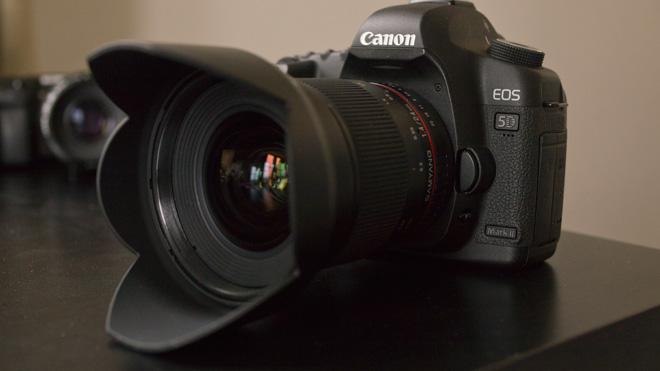
As good as Canon's renowned 24mm F1.4L? From Samyang? Maybe the title of the lens gives us a clue… AS IF.
In turns out those misguided initials aren't such a bad omen but the lens – at $850 / £550 has some price competition from the much cheaper Sigma 24mm F1.8.
Contents
- Resolution, sharpness
- Distortion
- Vignetting, light fall off
- Focus, breathing
- Flare
- Value for money
- Conclusion
I am reviewing the Canon mount version. You can get it now from Samyang's official worldwide dealer based in Europe. The DSLR video version has a de-clicked aperture ring for smooth and silent adjustment during a shot. Both lenses are the same price (for Canon mount).
The first things you notice about the Samyang 24mm F1.4 is that it is quite light for a full frame lens (there are no AF motors) and that the transmission of the glass is faster than other lenses at the same F stop.
The Samyang 24mm F1.4 is closer to T1.4 on a cinema lens in terms of brightness than most other lenses.
There is a significant difference in brightness when set to F2 relative to the Sigma 24mm F1.8. Below I've overlaid a cut out from the Sigma shot on the left onto the same area in the Samyang shot on the right – as you can see the Samyang is brighter by quite a noticeable margin!
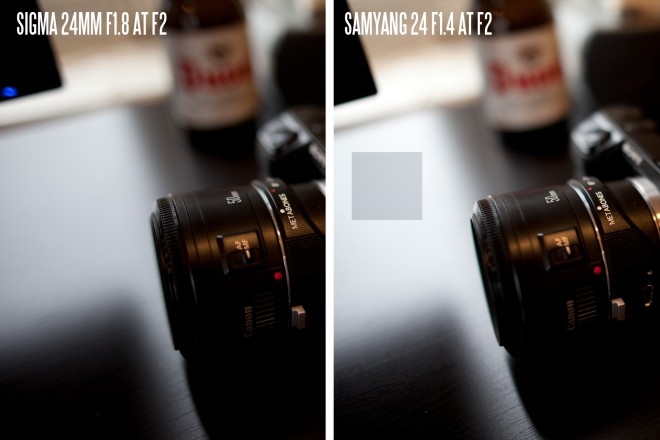
One of my favorite cinematic looks is at 24mm F1.4 on the 5D Mk II. Wider than 20mm is too extreme for my tastes, 28mm not quite dramatic enough. Shallow depth of field at wide angle is never shallower than on full frame. I recommend the Samyang 24mm F1.4 for the 5D Mark II and Nikon D800 / D4. On the GH2 the closest equivalent wide angle is the Olympus 12mm F2 and the (mostly unavailable) SLR Magic 12mm F1.6.
The Voigtlander 25mm F0.95 and the Samyang 24mm F1.4 give a similar feel on the GH2 since they are of similar focal lengths but really the lenses have different purposes on different bodies. The Nokton is an ultra fast portrait lens for Micro Four Thirds and the Samyang a fast wide angle for full frame.
Resolution, sharpness
Once again Samyang have produced a lens with Canon L style performance in terms of sharpness and resolution.
In the center there isn't much between the Samyang and Sigma but in the corners the Samyang is extraordinary! Big, big difference.
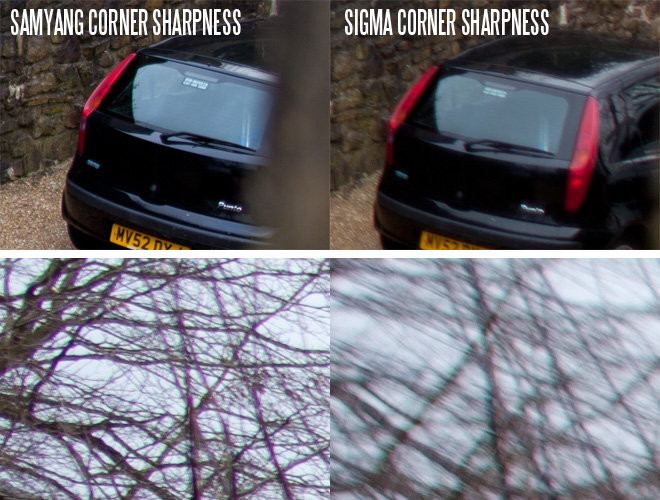
Below is the center sharpness… The Sigma is pretty good here. F1.8 on the Sigma shows none of the usual signs of a lens being wide open, and the performance is almost identical at F2 which is why that shot isn't included. The Samyang is softer at F1.4 wide open as you'd expect for F1.4 but has the edge at F2 as well as being brighter in terms of the real T-stop (light transmission of the glass).
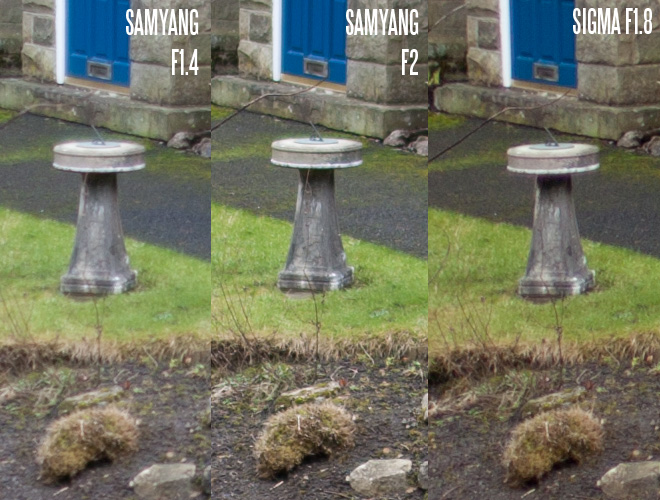
There is however an important factor to bear in mind here.
Soft corners may not be aesthetically bothering for some shots and can enhance the feel of a image. Soft corners and a slight vignette are part of what gives the Voigtlander Nokton 25mm F0.95 such a dreamy look wide open.
With the VAF-5D2 anti-aliasing filter, which brings far more benefits than negatives, you will get very soft corners with either lens, so the Samyang's advantage is canceled out. If you don't plan to use this and you want sharper corners for stills as well, the Samyang has definitely a sizeable advantage.
Distortion
As you'd expect there is barrel distortion, a little more than the Sigma 24mm F1.8. It is nowhere near as good as the Olympus 12mm on the GH2, but it isn't bad and most of the time you won't notice it. But I feel distortion is an area for Samyang to improve on.
Click image to full screen it:
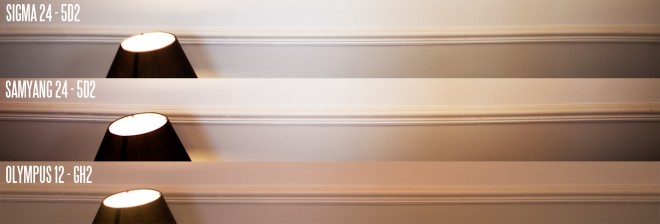
Vignetting, light fall off
Vignetting is slightly worse on the Samyang 24mm at F1.4 than the Sigma wide open at F1.8 but both are very similar at F2. I have to say this isn't a factor in my choice of lenses. In most normal shooting you will never notice it and the shot below represents the absolute worst case scenario where vignetting would be most noticeable. For me a bit of vignetting and light fall off in the corners actually adds to a cinematic image and all lenses have it at fast apertures. It is unavoidable.
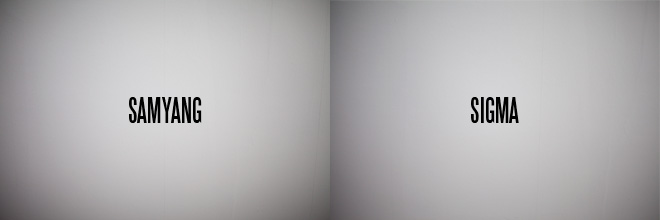
Focus, breathing
Whist the minimum focus distance is not as close as the Sigma 24mm F1.8 achieves, it is still very good.
Mechanically though the Samyang definitely has an advantage. It feels better with a longer, more precise travel and is better suited to a follow focus.
The Samyang is internally focusing, with only the rear element moving. The front element does not rotate or move back and forth like the Sigma and most other lenses.
Breathing is reduced compared to Samyang 35mm which was pretty bad in this regard. It does still breathe noticeably when stopped down (the background and framing will zoom slightly) but it is no worse than the Sigma 24mm F1.8 here and you rarely notice it unless racking some extremely fast focus changes at F8.
There's no AF on the Samyang, and this is part of why the price is attractive and the lens is light. However if you are interested in racking focus with an Oki USB follow focus or the Magic Lantern hack, you can only do that with the Sigma.
Flare and contrast wide open
Coating is improved compared to the Samyang 35mm F1.4 which has pretty crazy flare wide open. Contrast is also better wide open when a very bright light source is in the frame.
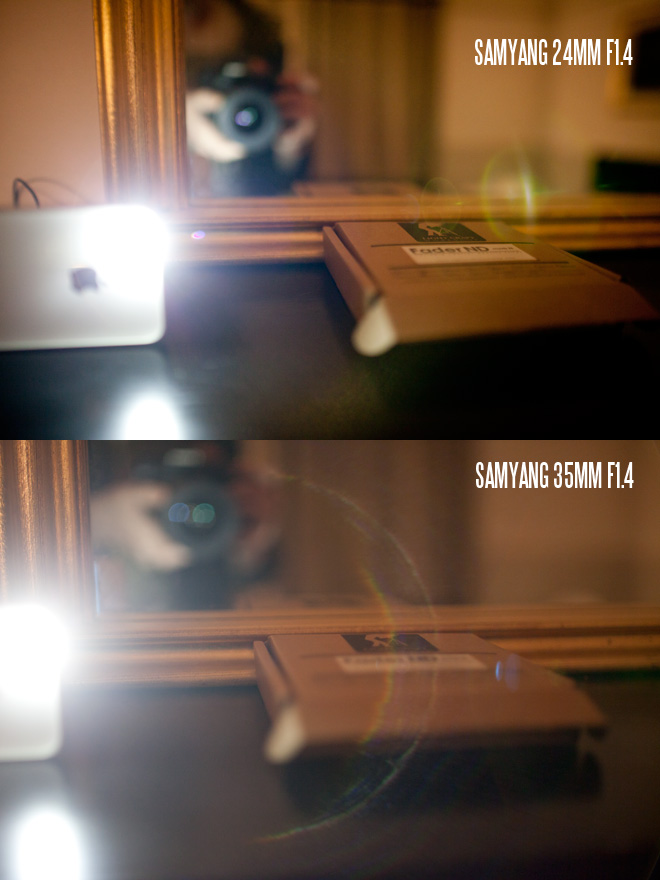
A very good performance – and it needed to be improved to be honest!
Value for money
The £500 / $850 Samyang 24mm F1.4 bucks the trend for Samyang's budget prices. The Samyang 35mm F1.4 was extremely popular at £350 / $550, likewise the 85mm F1.4 and 14mm F2.8 before it – both around the £250 / $400 mark. However as the $1500 / £1000 price tag of the Canon version shows this is a premium optic, and it is not easy to design a good 24mm F1.4. This is a more ambitious optical design than anything Samyang have done before.
There are not exactly manufacturers falling over themselves to do an affordable fast wide angle for full frame. The Samyang 24mm F1.4 costs half of what the Canon does BUT the Sigma 24mm F1.8 costs half of what the Samyang does! (If you pick one up on eBay). That Sigma is currently the cheapest fast wide angle lens with full frame coverage.
If you can justify the Samyang's extra cost for better corner sharpness, a faster aperture (and t-stop) and don't mind losing AF then the Samyang is the one to choose. For those who want more of a bargain, the Sigma is the one to get.
Conclusion
There is no doubting that the Samyang 24mm F1.4 is a better lens than the Sigma equivalent.
Affordable 24mm F1.4 lenses for full frame are relatively thin on the ground to say the least so if you want to look above the Samyang you have to step up to the mighty Canon 24mm F1.4L at double the cost.
Is it worth it? Probably not. Though I've not tested the Canon and Nikon lenses, the Samyang is so good that it is hard to see what the extra money will get you optically, apart from maybe less distortion and less flare.
So if you can justify the $850 – half the Canon but double the Sigma equivalents – the Samyang is definitely recommended and worth the money. It is a fantastic look on full frame.
The Sigma however, is even more of a bargain if you are…
B) Plan to use the VAF-5D2 anti-aliasing filter with a 24mm wide angle on the 5D Mark II for video
C) Don't mind a bit of corner sharpness and can sacrifice the faster aperture and better manual focus ring on the Samyang
Samyang announces 24mm f/1.4 ED AS UMC
#1 Vladimir P

- City: Siberia, however
#2 Painkiller

- User
- 872 messages
 Vladimir P (13.8.2011, 5:39) wrote:
Vladimir P (13.8.2011, 5:39) wrote:
#3 IdeaFix

- User
- 1,122 messages
- Yekaterinburg city
 Vladimir P (13.8.2011, 7:39) wrote:
Vladimir P (13.8.2011, 7:39) wrote:
small-image - small format. Full frame 24x36 is an oddly small format. I thought that only canonists tend to consider the pyadvak sensor “the largest in the world”, and enlightened people can call a small-format full frame “narrow”
Based on the literal translation, it becomes clear that the glass will work on both full-frame small format and crop.
Post edited by IdeaFix: 13 August 2011 - 17:44
#4 iceSS

- User
- 518 messages
#5 IdeaFix

- User
- 1,122 messages
- Yekaterinburg city
 iceSS (13.8.2011, 21:39) wrote:
iceSS (13.8.2011, 21:39) wrote:
35mm) and microformat (
16mm or less). But uzkar is already slang. Basically, it is applied specifically to film. To be honest, I don’t understand what prompted your clarification.
If they laid claim to the laurels of K.O. - will not work. for K.O. - It's me
Post edited by IdeaFix: August 13, 2011 - 18:47
#6 iceSS

- User
- 518 messages
#7 Andrey AM
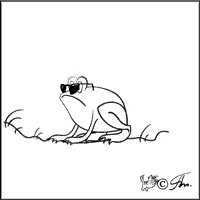
- Moderator
- 7,368 messages
- City: St. Petersburg
 Vladimir P (13.8.2011, 5:39) wrote:
Vladimir P (13.8.2011, 5:39) wrote:
#8 vb007

- User
- 16,132 messages
 Andrey AM (13.8.2011, 20:18) wrote:
Andrey AM (13.8.2011, 20:18) wrote:
#9 Alfred

- Moscow city
 iceSS (13.8.2011, 20:08) wrote:
iceSS (13.8.2011, 20:08) wrote:
#10 Andrey AM

- Moderator
- 7,368 messages
- City: St. Petersburg
 Bondezire (13.8.2011, 20:50) wrote:
Bondezire (13.8.2011, 20:50) wrote:
#11 IdeaFix

- User
- 1,122 messages
- Yekaterinburg city
 Andrey AM (13.8.2011, 23:10) wrote:
Andrey AM (13.8.2011, 23:10) wrote:
#12 Andrey AM

- Moderator
- 7,368 messages
- City: St. Petersburg
 IdeaFix (13.8.2011, 21:15) wrote:
IdeaFix (13.8.2011, 21:15) wrote:
#13 vb007

- User
- 16,132 messages
 IdeaFix (13.8.2011, 21:15) wrote:
IdeaFix (13.8.2011, 21:15) wrote:
#14 IdeaFix

- User
- 1,122 messages
- Yekaterinburg city
 Bondezire (13.8.2011, 23:35) wrote:
Bondezire (13.8.2011, 23:35) wrote:
I’m just looking at the secondary market for the cheapest medium format films (Kiev, Salyut, some Japanese and German) - it exists. And all sorts of old Zeiss mounts for B mount are a hot commodity. And the same Tair-33 in excellent condition is a rarity.
And if there is also a tilt/shift adapter for T2 or mounts for 50 bucks, but that’s a completely different story.
Lensbey lives at the expense of someone.
Post edited by IdeaFix: August 13, 2011 - 21:30
#15 iceSS

- User
- 518 messages
#16 The sea on a sunny day

- User
- 4,684 messages
 Vladimir P (13.8.2011, 5:39) wrote:
Vladimir P (13.8.2011, 5:39) wrote:
#17 IdeaFix

- User
- 1,122 messages
- Yekaterinburg city
 Pavel_back (16.8.2011, 19:00) wrote:
Pavel_back (16.8.2011, 19:00) wrote:
He is neither a lim nor a star. Isn't that enough?
But seriously, I, as a person who twirled it in my hands for an hour and a half and looked at my pictures later, was left with the following “precipitates”:
1. Vignette on holes up to 2.8.
2. Frankly crooked work of autofocus confirmation (although they probably tried a nickel and a dandelion here).
3. inconvenient aperture selection ring.
Yes, and it is somehow colorful, and at the same time with a very simple bokeh. Somehow one is dissonant with the other.
#18 Vladimir74
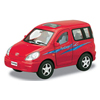
- User
- 420 messages
- Chelyabinsk city
IdeaFix
Hmm, what should the lens be like - with faded color and nervous bokeh?
I don’t like the size and weight of the Samyangs. And the prices don’t make me too happy considering their mediocre workmanship. You can buy the same used Nikkor 35 1.4 AIS cheaper.
But such a fast 24mm inspires respect! Of the competitors, it seems like only K and N for about 2 kilobucks?
Post edited by Vladimir74: 17 August 2011 - 09:36
#19 IOTNIK

- City: Kyiv
 IdeaFix (17.8.2011, 0:15) wrote:
IdeaFix (17.8.2011, 0:15) wrote:
#20 aaj
- User
- 1,184 messages
- City: St. Petersburg
As a crazy person who already has two Samyangs in his park, I will say one thing.
there is no need to revel in taste, it will lead to nothing other than “an argument among pigs about the taste of oranges compared to apples.” I am completely satisfied with both the 85m and 35m. and I used them exclusively for the last shoot. Weight and size are large. hmm, well, glass shouldn’t weigh much, if you don’t like it, buy plastic ones. By the way, I also have a Nikkor 35mm 1.4 Ai-s lens, which is unremarkable, I would even say rotten (for my taste and color, this marker does not smell like vanilla) (I refused Nikon’s 50mm 1.2 without regret, it didn’t shine either). The fact that it is smaller and lighter is of course yes, but we are talking about the Pentax system, and I have not yet seen adapters from Nikon to Pentax. If we talk about Nikon and Canon, then of course everyone is free to choose for themselves. And I’ll take the 24mm 1.4 from Samyang, as well as the 14mm, simply because these are good lenses and there are no competitors (price-quality) even close.
So we break away from taste preferences and try to find real competitors, of which, excuse me, there are none (personal opinion, of course).
By the way LensBaby. this is really a toy, I played with it and now I don’t know how to use it =((I don’t know how to cook it).
#21 Vladimir74

- User
- 420 messages
- Chelyabinsk city
aaj
So, Pentax doesn’t have 35 1.4. That's why I compared the price with this expensive Nikkor. I read good reviews about it. But you, as the owner, know better, of course.
But there’s no need to tell horror stories about huge heavy glass and metal here at the Pentaclub, where every second person has a lim or takumar. Well, Samyang doesn’t know how to make compact lenses. If you personally go with Mark, then yes - it’s no longer critical for you.
Post edited by Vladimir74: 17 August 2011 - 10:36

